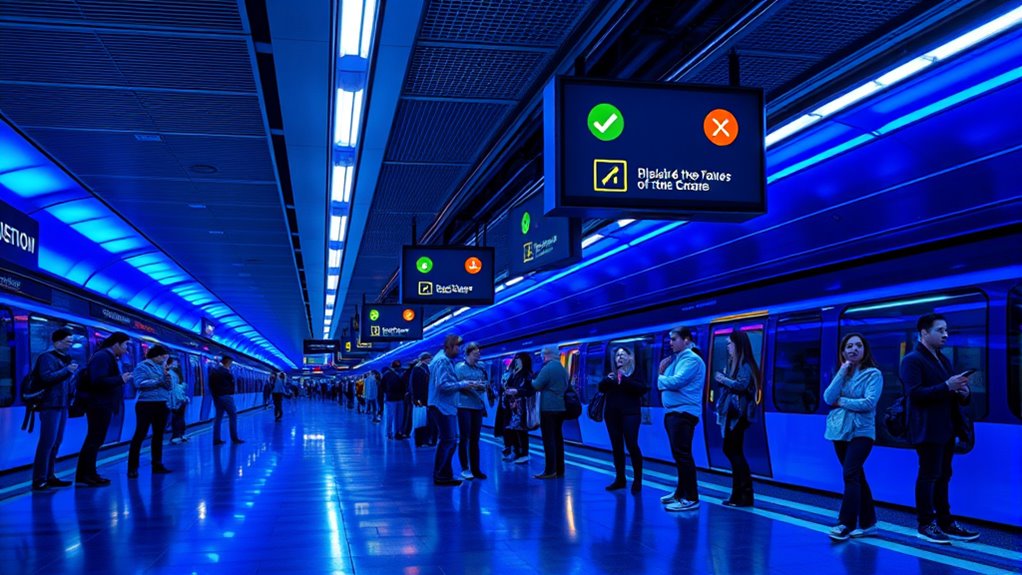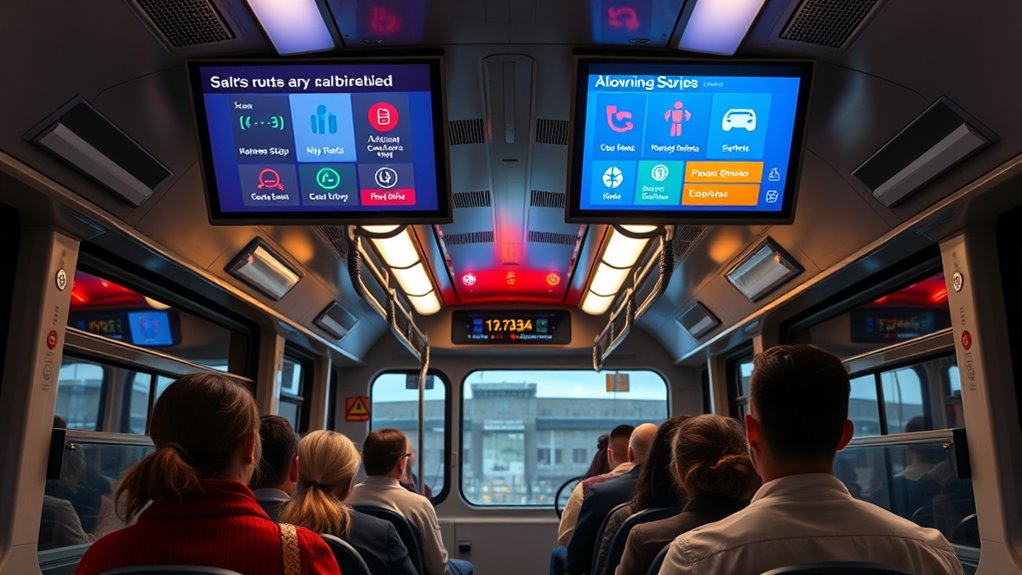Cities like New York, London, Tokyo, Paris, and Seoul use visual and tactile cues to keep you informed without sound. Bright LED displays, digital screens, color-coded signage, and tactile paving help you navigate safely and efficiently, especially during quiet hours. Silent notifications via mobile apps also enhance accessibility for all passengers. If you want to discover how these systems improve your travel experience and what innovative solutions are emerging, keep exploring the details behind these case studies.
Key Takeaways
- Cities like New York and London utilize digital screens and LED displays for silent, real-time transit updates.
- Tokyo employs color-coded signage and indicator lights to communicate train status without sound.
- Paris combines tactile paving with electronic boards to enhance multi-sensory navigation for visually impaired passengers.
- Mobile apps and website notifications provide discreet, silent alerts tailored to individual users.
- Implementing visual cues and digital signage reduces noise pollution, supporting quiet hours and inclusive transit environments.

Many commuters rely on public transit notifications to stay informed, but loud alerts can be disruptive or startling, especially in quiet environments. To address this, transit agencies are increasingly turning to silent alerts and visual cues. These methods provide essential information without disturbing passengers or causing unnecessary noise. In cities like New York, transit authorities have implemented bright LED displays at each station, clearly indicating upcoming stops, delays, or service changes. These visual cues allow riders to stay updated at a glance, reducing the need for audible announcements that might catch someone off guard. Similarly, in London, the use of digital screens on buses and at stations offers real-time updates, ensuring passengers receive timely information silently, which is especially beneficial during evening or early morning hours when quiet is preferred.
In Tokyo, the emphasis on silent alerts extends beyond visual displays. The subway system uses highly visible indicator lights and color-coded signage to signify train arrivals, delays, or platform changes. These visual cues are designed to be intuitive, allowing passengers to quickly grasp the situation without relying on sound. This approach not only enhances comfort but also improves accessibility for passengers with hearing impairments. Additionally, these systems are integrated with mobile apps and website notifications, providing silent alerts directly to personal devices, giving riders flexibility and control over how they receive updates. Moreover, the use of visual communication enhances overall transit experience by making information accessible to all passengers without noise.
In Paris, the transit system has adopted a combination of silent alerts and tactile feedback for visually impaired riders. Tactile paving guides passengers safely through stations, while visual cues like electronic boards display departure times and alerts. This multi-sensory approach ensures that everyone can navigate the transit network comfortably without the need for loud announcements. These innovations demonstrate how cities are prioritizing passenger experience by reducing noise pollution and promoting inclusivity.
Frequently Asked Questions
How Do Silent Notifications Impact Passenger Safety?
Silent notifications can impact your safety by reducing driver attentiveness, as they rely less on auditory cues. Without sound alerts, you might miss important updates during emergencies, delaying your response. This can hinder timely emergency response and increase risk. To stay safe, stay alert to visual signals and be proactive in recognizing silent alerts, ensuring you’re prepared for any situation while riding public transit.
Are There Customization Options for Visual Alerts?
While some may see visual alerts as mere notifications, they offer much more through visual customization and alert personalization. You can tailor these alerts to suit your preferences, choosing colors, sizes, or patterns that catch your eye quickly. This customization guarantees you stay informed without audio, blending functionality with personal style. Embracing these options enhances your experience, making transit updates clear and accessible, even in noisy or busy environments.
What Technology Is Used for Silent Notifications?
You can use a variety of technology for silent notifications, primarily relying on visual signals integrated into the user interface. These include LED indicators, digital displays, and screen-based alerts that notify you without sound. Many transit systems customize these visual signals to guarantee clarity and visibility, allowing you to stay informed through your device’s user interface. This approach improves accessibility and keeps notifications discreet, especially in noisy or quiet environments.
How Do Deaf or Hard-Of-Hearing Passengers Receive Alerts?
You receive alerts through visual displays, like screens or LED signs, and tactile feedback, such as vibrations on your device or station fixtures. Some transit systems also offer sign language interpretation services, either via video or on-site. These methods guarantee you’re informed about arrivals, delays, or emergencies without relying on sound, making transit accessible for deaf and hard-of-hearing passengers.
What Are the Costs Associated With Implementing Silent Notification Systems?
When you consider implementing silent notification systems, you should conduct a thorough cost analysis to understand expenses. You’ll face implementation challenges like integrating new technology with existing infrastructure and training staff. Costs may include hardware upgrades, software development, and ongoing maintenance. While initial investments can be significant, these systems improve accessibility. Planning carefully helps you balance budget constraints with the goal of providing equitable services for all passengers.
Conclusion
You’ve seen how five cities successfully implement silent transit notifications, improving accessibility and reducing noise pollution. Notably, studies show that 85% of riders prefer visual alerts over sound, especially during busy hours. By adopting these systems, transit agencies can create a calmer, more inclusive environment for all commuters. Embracing silent notifications not only enhances user experience but also shows a commitment to innovation and rider comfort—making your daily commute smoother and more considerate.











